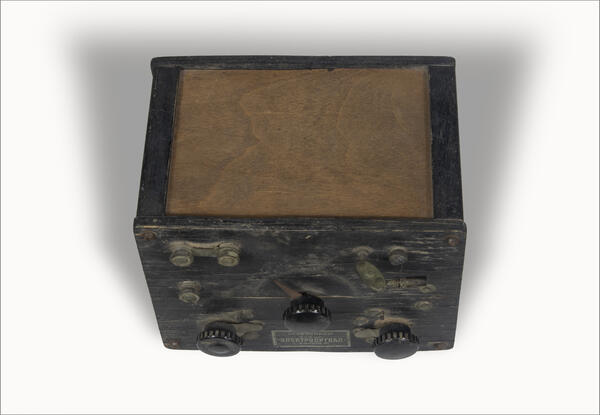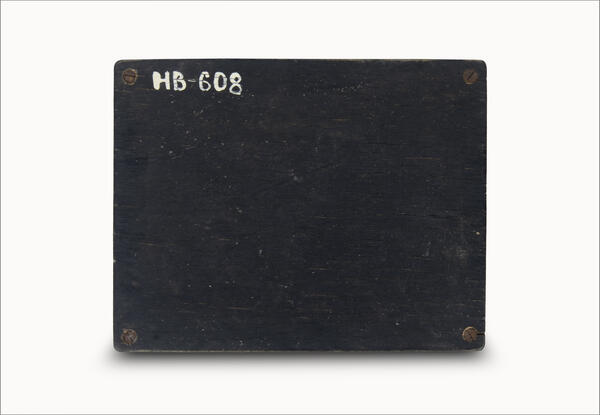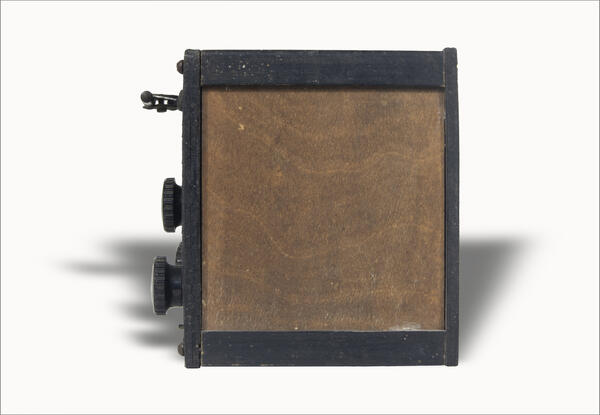During the Great Patriotic War, the detector radio was used by the inhabitants of the village of Timashovo, Kaluga Oblast, to listen to reports from the Soviet Information Bureau. In 1941, when the Nazi invaders approached Moscow and were close to the village, the radio set was buried in an underground cache along with other valuables. Soon after the liberation of the village Timashovo the villagers took the radio set out of the ground and it still functioned. The radio receiver was installed in the village’s reading room, where local people regularly gathered to listen to the latest news from the war front.
The Soviet radio receivers model “P-8” started to be produced in 1928 at the Nizhny Novgorod Telephone Plant named after Lenin, which was part of the “Elektrosvyaz” trust. The model was based on the mass produced detector radio model “P-5” and differed from it by a narrower wave range. It allowed to listen to radio broadcasts on a wavelength range from 300 to 1875 meters. The radio “P-8” made by Voronezh radio plant “Electrosignal” is on display in the Museum of the History of Obninsk. The factory started the production of this model of detector radio receivers on June 7, 1934.
The detector receiver does not require additional power, it uses the energy of the radio signal. For good performance, the radio receiver requires an antenna of at least 10 meters long and a good ground connection. The main part of the radio receiver is the detector, a simple diode made from a thin wire pressed onto a galena crystal.
When tuning the receiver for the first time, it is necessary to find the point on the surface of the crystal where a semiconductor effect occurs between the end of the wire and the galena, and the sound vibrations appear in the headphones. To tune the receiver to the frequency of the radio station, it was necessary to turn a special knob. This changed the mutual position of the two coils of copper wire inside the receiver body, and the signal could be heard in the background noise.
The receiver weighs 980 grams. It was designed with a three-level variable capacitor control, which allowed a marked increase in tuning selectivity. The “P-8” was one of the most advanced radio receivers of the mid–1930s.
The Soviet radio receivers model “P-8” started to be produced in 1928 at the Nizhny Novgorod Telephone Plant named after Lenin, which was part of the “Elektrosvyaz” trust. The model was based on the mass produced detector radio model “P-5” and differed from it by a narrower wave range. It allowed to listen to radio broadcasts on a wavelength range from 300 to 1875 meters. The radio “P-8” made by Voronezh radio plant “Electrosignal” is on display in the Museum of the History of Obninsk. The factory started the production of this model of detector radio receivers on June 7, 1934.
The detector receiver does not require additional power, it uses the energy of the radio signal. For good performance, the radio receiver requires an antenna of at least 10 meters long and a good ground connection. The main part of the radio receiver is the detector, a simple diode made from a thin wire pressed onto a galena crystal.
When tuning the receiver for the first time, it is necessary to find the point on the surface of the crystal where a semiconductor effect occurs between the end of the wire and the galena, and the sound vibrations appear in the headphones. To tune the receiver to the frequency of the radio station, it was necessary to turn a special knob. This changed the mutual position of the two coils of copper wire inside the receiver body, and the signal could be heard in the background noise.
The receiver weighs 980 grams. It was designed with a three-level variable capacitor control, which allowed a marked increase in tuning selectivity. The “P-8” was one of the most advanced radio receivers of the mid–1930s.





